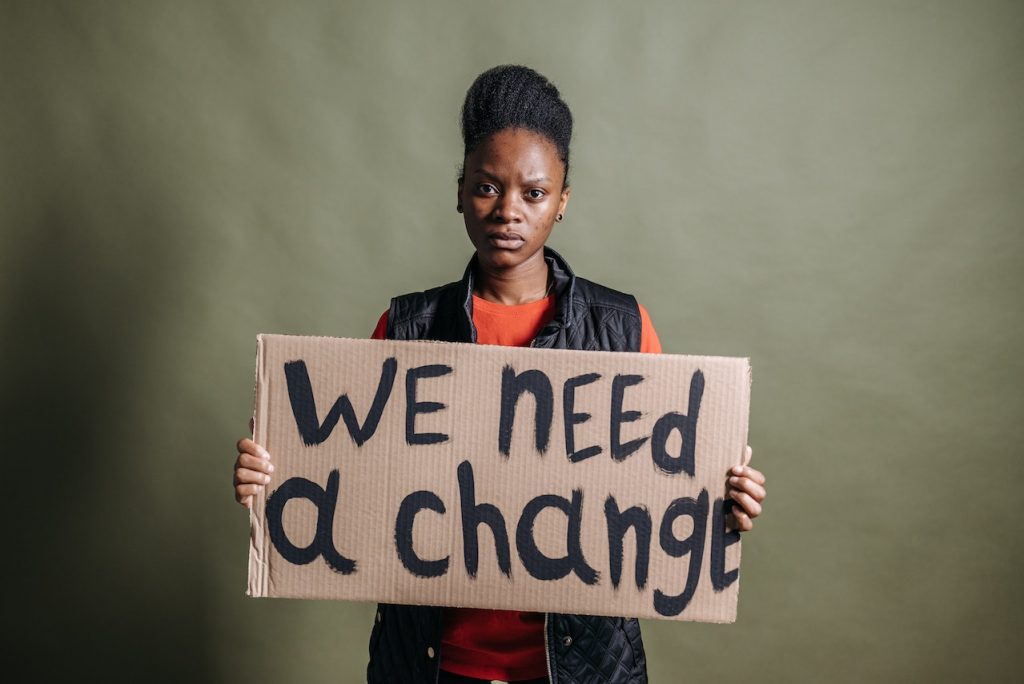
GUEST POST from Teresa Spangler
At the time of my writing this, the world is in the midst of unprecedented triple crises. The COVID-19 pandemic is wreaking havoc on healthcare and on the personal lives of people globally. The economic impacts of this pandemic are crippling nations, small towns, and people all over the world. And to top it off we are experiencing incredible social unrest – protests for Black Lives Matter are taking shape all around the world, with the goal of peaceful protests for change – but they’ve been hijacked by anarchists of varied profiles… individual crusaders, terrorists acting solo, antagonists of the left and the right wings… so many different factions creating chaos. All of this to say, change is happening at paces unimaginable, and ‘INNOVATION for Good’ – of all types, centered on human, economic, and environmental impacts – is a dire necessity.
The world faces many great challenges. For example, the World Economic Forum reports that “by 2050, global food systems will need to sustainably and nutritiously feed more than 9 billion people while providing economic opportunities in both rural and urban communities. Yet our food systems are falling far short of these goals. A systemic transformation is needed at an unprecedented speed and scale.”
Speed and scale, these days, are the operative words prioritized in innovation investments. When and how are the big questions that investors and stakeholders primarily ask? Of course, these are important questions. Breaking the cycle of ‘profit first’ is not an easy shift for capitalist societies. Social Entrepreneurism, Social Innovation Organizations, and Non-Governmental Organizations are charting courses toward innovating in new and socially impactful ways, but they need the support, collaborative partnership, and help from investors and from the public and private sectors. The world of business has been groomed for years to drive everything fast, faster, and fastest – fail-fast, rapid prototype, accelerated stage gates, hire-slow-fire-fast, rapid returns… and so on. Measured return on investments drives innovation decision-making from new cure-all drugs to the closet full of patents that sit in the coffers of giant industry leaders never making it out into the commercial world, even though these may be game-changing, lifesaving, humanity-improving innovations.
This chapter looks at examples of how to shift from ‘profit first’ to ‘ethics and innovation for good and safety first’. If you build it safely, ethically, and build it to serve humanity, improve the environment, and support socially good causes, the profits will come. But investors and stakeholders need to understand the WHYs – why safety, ethics, and serving are so important. How are we innovators sharing these three critical priorities in the stories we build to gain buy-in on new ideas? So often, safety and ethics are afterthoughts. Responsible Innovation: Ethics and Risks of New Technologies, Joost Groot Kormelink, TU Delft Open, 2019 note:
“If we do not critically and systematically assess our technologies in terms of the values they support and embody, people with perhaps less noble intentions may insert their views on sustainability, safety and security, health and well-being, privacy and accountability.”
Also in the textbook, Responsible Innovation: Ethics and Risks of New Technologies, it sites are case study examples of how conflicting values can open up new opportunities to innovate responsible. As a learning method, the case study opens up our minds to the point of view or moral foundations as an opportunity:“Moral dilemmas can help stimulate creativity and innovation, and innovative design may help us to overcome problems of moral overload.”
In the case study excerpt below: “Smart meters and conflicting values as an opportunity to innovate.” The case study points to an example of smart meter design.
The smart meter 3.0, which is what we are ideally looking for, is designed to accommodate both of the functional requirements in order to make energy use more efficient, while also protecting personal data. It gives us privacy and sustainability. In this respect, innovation in smart metering is exactly this: the reconciliation of a range of values, or moral requirements, in one smart design, some of which were actually in conflict before. Similarly, if we would like to benefit from RFID technology (enabling to automatically identify and track tags attached to objects) in retail, but fear situations in which we might be tracked throughout the shopping mall, it has been suggested we can have it both ways. A so-called ‘clipped chip’ in the form of a price tag with clear indentations would allow customers to tear off a piece of the label, thereby shortening the antenna in the label so as to limit the range in which the label can transmit data.
Clarity of Values-Based Purpose
In the case above, there is clear purpose-driven innovation. Study after study has shown clarity of purpose is key to engaging people in new ideas.
A Kin&Co survey conducted by Populus points out that “Not embedding purpose properly also alienates customers, because in this age of transparency employee problems leak out online, and into the press. Over a third of employees surveyed (34%) said they’d consider writing a negative review online.” One example cited is of “… the Etsy employee who started a petition against the company’s leaders for not living their purpose and values, which was signed by thousands of employees and then went viral.” From: Why purpose matters and four steps companies can take to get it right”, Rosie Warin, 14 February 2018, Ethical Corporation Magazine, Reuters Events – Sustainable Business, the conclusion was thus that …
Having a purpose and not living it will actually hurt your business more than not having one at all! Why Purpose Matters
There is a hunger for more transparency, having our work be meaningful, and knowledge that ethics and privacy are forethoughts, not afterthoughts. It’s good for business, and certainly will drive better profits in the long run.
Breaking the ‘Fast Profit’ Addiction and Adapting Innovation for Social Benefits – Seeking Purpose
Without tradition, art is a flock of sheep without a shepherd. Without innovation, it is a corpse. Winston Churchill
What if we asked the BIG ‘What if?’ What if we were more focused on the benefits of our innovations to humans, the environment, and society – making these priorities over profits first? Can it be proven that if you build it, the profits will come?
The United Nations: Sustainable Development Goals (SDGs)
The chapter Foundations of Moral Innovation (Chapter 3 – page 57) mentioned the ‘triple bottom line’ that socially conscious companies focus on serving – People / Planet / Profit… the social, environmental, and financial aspects of an organization’s impact. In 2015 the United Nations cast a vision (and put actions to their words) to build a better world for all people by 2030. Engaging a world of collaborators is key to the success of these 17 Development Goals (noted below).
“The 17 Sustainable Development Goals (SDGs) are one of the world’s best plan to build a better world for people and our planet by 2030. Adopted by all United Nations Member States in 2015, the SDGs are a call for action by all countries – poor, rich and middle-income – to promote prosperity while protecting the environment. They recognize that ending poverty must go hand-in-hand with strategies that build economic growth and address a range of social needs including education, health, equality, and job opportunities, while tackling climate change and working to preserve our ocean and forests. See Transforming A World: A 2030 Agenda.
The Division for Sustainable Development Goals (DSDG) within the United Nations Department of Economic and Social Affairs (UNDESA) provides substantive support and capacity-building for these SDGs and their related thematic issues.
To say the least, as we read these 17 audaciously massive and impactful goals, the goals feel incredibly lofty; the actions to innovate solutions for three of the goals, much less 17 of them, feels nearly unachievable (in our fast prototyping, rapid release, ROI-focused, capitalistic mind-sets) and CFOs around the world sense that acting on these in any way may weigh heavily on profits. Yet many companies are collaborating to drive solutions to these goals. The United Nations built a values-based and purpose-driven platform to participate in solving these world challenges. They provide guidelines, research, information on other collaborators, tools, data, and so much support to help those that choose to participate. And participating they are! Noted from a press release in July 2019: “28 companies with combined market cap of $1.3 trillion step up to new level of climate ambition. Ahead of the UN Climate Action Summit, companies commit to set 1.5°C climate targets aligned with a net-zero future, challenging Governments to match their ambition”.
Here are a few of the participating companies from this release: AstraZeneca, Banka BioLoo, BT, Dalmia Cement Ltd., Eco-Steel Africa Ltd., Enel, Hewlett Packard Enterprise, Iberdrola, KLP, Levi Strauss & Co., Royal DSM, SAP, Signify, Singtel, Telefonica, Telia, Unilever, Vodafone Group PLC, and Zurich Insurance, amongst others. The release goes on to note that this collectively represents over one million employees from 17 sectors and more than 16 countries.
It seems that the United Nations has created an intensely collaborative framework that offers a moral ground to innovate. It’s just one example, and as complex as these goals are, the framework is simple… build a mission-driven platform, engage thought-leaders around the world, set up metrics and measures for success, provide as much data as possible, offer support when and where needed, and provide as many tools as possible to encourage collaboration amongst them.
ESG – A Moral Compass
Social investors are a group growing in popularity and size. These investors focus their investments and their portfolios on corporations around the world with metric-driven processes to ensure they are building sustainable and responsible companies – a practice known as environmental, social and corporate governance, or ESG.
An example of such an organization is Philips Corporation, which has made a commitment to ESG and thus to ethics over profits. In the article, “Good business: Why placing ethics over profits pays off”, they share “When companies work ethically, they will naturally outpace competition. Why? Simply because customers, as we’ve discovered, will see them as a trusted partner, not only for what they do, but how it is delivered. Commitment from management is a key factor to effectively deal with these situations.”
In Stanford Social Innovation Review, authors Chris Fabian and Robert Fabricant write, “An ethical framework – ‘a way of structuring your deliberation about ethical questions’ – can help to bridge disparate worlds and discourses and help them work well together.” Their article further notes that, “Ethical questions might include: ‘Is this platform / product actually providing a social good?’ or ‘Am I harming / including the user in the creation of this new solution?’ or even ‘Do I have a right to be taking claim of this space at all?’”11 Such a strong ethical framework can help innovators to plan for ‘value-based collaborations’. Establishing such a framework within your innovation practice also provides a process whereby collaborators can monitor the work, and consistently ensure that ethics are intact. Moreover, planning for positive outcomes and managing to an ethical framework gives customers, buyers, stakeholders, users, and investors some comfort that the ‘net new disruptive innovations’ will be safe for all, which will result in strong profits and longevity in due time.
Very importantly, this article also points out that while ethics may involve subjectivity, nevertheless “an ethical framework can bridge the worlds of startup technology companies and international development to strengthen cross-sector innovation in the social sector.”
Fabian and Fabricant outline a 4-model framework in this article:
- Innovation is humanistic: solving big problems through human ingenuity, imagination, and entrepreneurialism that can come from anywhere.
- Innovation is non-hierarchical: drawing ideas from many different sources and incubating small, agile teams to test and iterate on them with user feedback.
- Innovation is participatory: designing with (not for) real people.
- Innovation is sustainable: building skills even if most individual endeavors will ultimately fail in their societal goals.
“Critical to the world’s innovation effort is harvesting the Human Imagination!” Patrick Reasonover – writer and producer of They Say It Can’t Be Done
Incorporating any of the above four models provides the basis for forethought and planning. There may be additional considerations accompanying the above framework to drive even better outcomes yet – especially for those with big audacious visions of disruptive innovation. But often there are unexpected barriers. So how can one plan for the unexpected? There is a documentary film that explores some of these barriers, and four companies working to overcome them.
They Say It Can’t Be Done, written and produced by Patrick Reasonover, is an excellent documentary exploring how innovation can solve some of the world’s largest problems. The film tracks four companies on the cutting edge of technological solutions that could promote animal welfare, solve hunger, eliminate organ wait lists, and reduce atmospheric carbon. The film explores often unexpected challenges and barriers that are potentially keeping these companies from realizing success. They each share steps and strategies on how to break through the ‘concrete walls’.
The compelling theme from these companies is innovation for good – innovation with a moral foundation to improve humanity. One of the first questions typically asked by stakeholders is “When will these companies or their new innovations become profitable?” Here’s the BIG ‘What if’ question. What if we changed this question to, “What will it take to make this successful, and how can we help you get there faster?” These are fairly typical questions. But what about roadblocks potentially challenging even the most knowledgeable and experienced teams and proven technologies? I recently spoke with Patrick Reasonover about his mission and the documentary. Reasonover shares, “Faced with similar challenges to the companies in the documentary, I felt if more people understood barriers, the world would see more successful outcomes that could save people, improve human conditions, and the environment.” Reasonover went on to share four themes that would greatly help disruptors in their innovation practices. These four themes are summarized as follows:
- One of the most important points he made in our discussion was to engage regulators and government agencies – collaborating with them very early on in the process and all along your path. Help them to understand; listen and take in their input.
- Institute what Reasonover calls an ‘Ambassador of Imagination’. We need more imagination in the world and in our own world. It’s too easy to get boxed into an innovation framework and forget to take the blinders off in order to think and create big things!
- Optimism is sorely needed in the world and especially for innovators. Getting new things out the door is daunting. Infuse your efforts with doses of optimism grounded in reality.
- CELEBRATE… hitting milestones should be celebrated along the way. It’s a long road, and all too often we get push back from doubters, investors wanting faster outcomes, governing approval agencies, and so on. Celebrate and move forward!
These four practices create a culture that encourages and celebrates imagination, innovation, success, and all the collaborators helping you get there. And involving agencies early on in the process helps them to understand that you are taking safety and ethics seriously. Take for example 3D-printed organs for those needing transplants. There is so much at stake. Stepping through the approval process to prove it out on less risky organs – for example, 3D printed ears – helps to chart the course for other organs as the technologies and the discovery of new methods continues to develop.
The article “On The Road To 3-D Printed Organs” in TheScientist reports, “There are a number of companies who are attempting to do things like 3-D print ears, and researchers have already reported transplanting 3-D printed ears onto children who had birth defects that left their ears underdeveloped, notes Robby Bowles, a bioengineer at the University of Utah. The ear transplants are, he says, ‘kind of the first proof of concept of 3-D printing for medicine.”
Ethics First
All in all, there is much evidence pointing to success, longevity, scale, and profits when building a framework that places ethics, safety, values, and purpose as planned practices in any innovation effort.
These practices do not have to slow the process of innovation in the least. On the contrary… they will often speed up the effort, as in the example of engaging regulators as collaborators early on in your efforts. Engaging imagination and optimism are sorely needed, and keeps teams engaged and enthused. And.. leveraging one of Stanford’s four models could save a great deal of pain by monitoring outcomes all along your development stage gates. It all just makes good and safe business sense!
*Article is an excerpt contribution (chapter 6): The Other Side of Growth: Innovator’s Responsibilities in an Emerging World
Image credit: Pixabay
 Sign up here to get Human-Centered Change & Innovation Weekly delivered to your inbox every week.
Sign up here to get Human-Centered Change & Innovation Weekly delivered to your inbox every week.

![]() Sign up here to get Human-Centered Change & Innovation Weekly delivered to your inbox every week.
Sign up here to get Human-Centered Change & Innovation Weekly delivered to your inbox every week.







